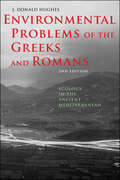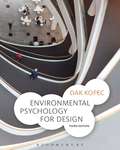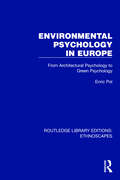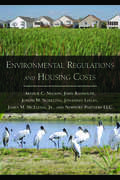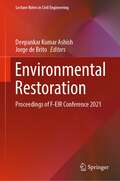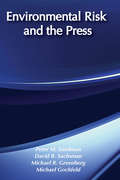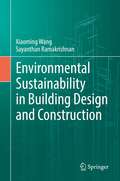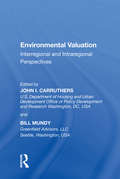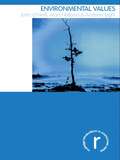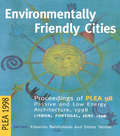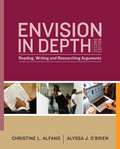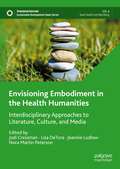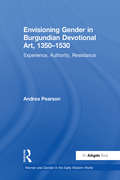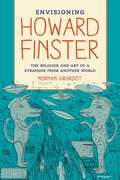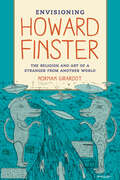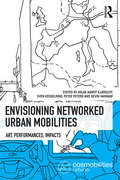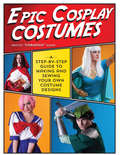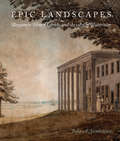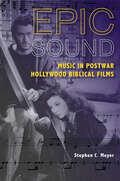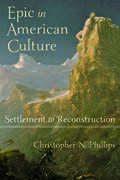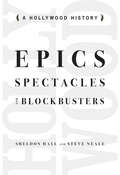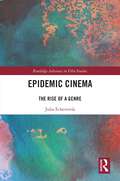- Table View
- List View
Environmental Problems of the Greeks and Romans: Ecology in the Ancient Mediterranean (Ancient Society and History)
by J. Donald HughesHow did ancient societies change the environment and how do their actions continue to affect us today?In this dramatically revised and expanded second edition of the work entitled Pan’s Travail, J. Donald Hughes examines the environmental history of the classical period and argues that the decline of ancient civilizations resulted in part from their exploitation of the natural world. Focusing on Greece and Rome, as well as areas subject to their influences, Hughes offers a detailed look at the impact of humans and their technologies on the ecology of the Mediterranean basin. Evidence of deforestation in ancient Greece, the remains of Roman aqueducts and mines, and paintings on centuries-old pottery that depict agricultural activities document ancient actions that resulted in detrimental consequences to the environment. Hughes compares the ancient world's environmental problems to other persistent social problems and discusses attitudes toward nature expressed in Greek and Latin literature. In addition to extensive revisions based on the latest research, this new edition includes photographs from Hughes's worldwide excursions, a new chapter on warfare and the environment, and an updated bibliography.
Environmental Psychology for Design
by Dak KopecHow does a room affect an occupant's behavior and well-being? How does a building influence its residents' health? Environmental Psychology for Design, 3rd Edition, explores these questions with an in-depth look at psychosocial responses to the built environment. Awarded the 2006 ASID Joel Polsky Prize, the first edition served as an introduction to the discipline of environmental psychology and inspired readers to embrace its key concepts and incorporate them into their practice. This 3rd edition continues to analyze the interaction between environments and human behavior and well-being, while exploring how individual differences related to age, gender, and cultural background impact that interaction.
Environmental Psychology in Europe: From Architectural Psychology to Green Psychology (Routledge Library Editions: Ethnoscapes)
by Enric PolOriginally published in 1993, as part of the Ethnoscapes: Current Challenges in the Environmental Social Sciences series, reissued now with a new series introduction and new preface, Environmental Psychology in Europe: From Architectural Psychology to Green Psychology sets out to explain the nature of environmental psychology, how it was born, how it developed, what were its dominant subjects, its principal actors and its present state in Europe at the time. The volume covers each European country, looking at the origin and development of the subject in the principal European cultural areas.
Environmental Regulations and Housing Costs
by Jonathan Logan Arthur C. Nelson Llc Newport Partners Joseph M. Schilling James M. Mcelfish John RandolphMany communities across the nation still lack affordable housing. And many officials continue to claim that "affordable housing" is an oxymoron. Building inexpensively is impossible, they say, because there are too many regulations. Required environmental impact statements and habitat protection laws, they contend, drive up the costs of construction. But is this actually true? In a comprehensive study of the question, the authors of this eye-opening book separate fact from myth. With admirable clarity, they describe the policy debate from its beginning, review the economic theory, trace the evolution of development regulation, and summarize the major research on the topic. In addition, they offer their own research, accompanied by a case study of two strikingly different Washington, D.C., suburbs. They also include results of focus groups conducted in Dallas, Denver, and Tucson. The authors find that environmental regulatory costs--as a share of total costs and processes--are about the same now as they were thirty years ago, even though there are far more regulations today. They find, too, that environmental regulations may actually create benefits that could improve the value of housing. Although they conclude that regulations do not appear to drive up housing costs more now than in the past, they do offer recommendations of ways in which the processes associated with regulations--including review procedures--could be improved and could result in cost savings. Intended primarily for professionals who are involved in, or impacted by, regulations--from public officials, planners, and engineers to housing developers and community activists--this book will provide useful insights and data to anyone who wants to know if (and how) American housing can actually be made "affordable."
Environmental Restoration: Proceedings of F-EIR Conference 2021 (Lecture Notes in Civil Engineering #232)
by Jorge De Brito Deepankar Kumar AshishThis book gathers peer-reviewed contributions presented at the F-EIR Conference 2021, Environment Concerns and its Remediation, held in Chandigarh, India, on October 18-22, 2021. The respective papers focus on environmental monitoring and remediation, and cover topics such as efficiency in the use of energy, water, resources and human capital, waste minimization & management, durability and sustainability of building materials, green technologies, environmental sustainability and resilience, renewable energy, prevention and management of water pollution, life cycle assessment, and climate change. Accordingly, the book offers a valuable, up-to-date tool and essential overview of the subject for scientists and practitioners alike, and will inspire further investigations and research.
Environmental Risk and the Press
by Peter M. SandmanToxic spills, acid rain, poor air quality-scarcely a day goes by without a report in the press on an environmental risk issue. Nowhere is this more prevalent than in New Jersey, a leading state in the production of chemicals, and the state with the largest number of Superfund cleanup sites. How accurate and how extensive is environmental risk reporting in the New Jersey press, and what can be done to improve the quality of its coverage of environmental risk? And what can we learn from the New Jersey experience?Environmental Risk and the Press sets out to answer these questions. The authors explore the strengths and weaknesses of environmental risk reporting in New Jersey by evaluating the state's best environmental risk stories. They find that even the best stories have a number of problems, and they develop a number of concrete recommendations for reporters and editors on how to improve their coverage in this area.The authors also investigate the feasibility of various methods for getting environmental risk information to reporters and into their newspapers. They recommend three ways to improve the quality of environmental risk information available to journalists. The first is nationwide distribution of environmental press kits that include a directory of news sources, a glossary of technical terms, and briefings by experts on strategies for covering particular types of environmental risk situations. The second is continuing education programs on environmental risk for reporters and editors. The third is creating collections of relevant reference books in the offices of newspapers and broadcast stations. The authors report on initial actions taken to implement these recommendations, and plans for others. They conclude that the broader availability of environmental risk information to the media will result in better reporting of environmental problems. This book is a first step toward enhancing journalists' appreciation of the importance of risk as an issue in environmental news coverage, and providing them with the tools to help them act upon that heightened awareness.
Environmental Sustainability in Building Design and Construction
by Xiaoming Wang Sayanthan RamakrishnanThis monograph offers analyses of construction activities using various key concepts and assessments of sustainable development, and provides students and researchers with methodologies and design aspects for the sustainable development of the built environment. Additionally, the book demonstrates various national and international policies for assisting architects, engineers and policy makers in understanding the relevant decision-making approaches to sustainable development in construction. The book begins by reviewing the background of sustainability and sustainable development. The focus then turns to the effects of climate change on the built environment, including impacts of energy and carbon emissions, as well as constraints on water and waste management. The remaining chapters discuss the necessary approaches to achieve sustainable waste management, energy efficient building design, and resilience and adaptation in the built environment In eight chapters, the book encourages readers to think independently, logically and objectively about the complex issues presented by the applications of sustainable development in construction, including resource efficiency, environmental impacts, human health, building economics and social development.
Environmental Valuation: Interregional and Intraregional Perspectives (Urban Planning And Environment Ser.)
by Bill MundyEnvironmental quality is one of the most important issues faced by contemporary urban and regional policy. Amenities such as access to the natural environment, attractive neighbourhood characteristics and high quality public goods and services, play a direct role in determining where people choose to live and how much they are willing to do so. Likewise, negative environmental conditions, such as contamination, influence the real estate markets and the 'value' of a region. Increasingly, regions become winners or losers based on the quality of life they offer their inhabitants. Bringing together a team of leading scholars, this book addresses the issues of environmental valuation, answering questions such as: What kinds of features matter? How large of an affect do they have? How do they affect the spatial distribution of the population? And how should the value that people place on their environment affect urban and regional policy?
Environmental Values
by Andrew Light John O'Neill Alan HollandWe live in a world confronted by mounting environmental problems; increasing global deforestation and desertification, loss of species diversity, pollution and global warming. In everyday life people mourn the loss of valued landscapes and urban spaces. Underlying these problems are conflicting priorities and values. Yet dominant approaches to policy-making seem ill-equipped to capture the various ways in which the environment matters to us. Environmental Values introduces readers to these issues by presenting, and then challenging, two dominant approaches to environmental decision-making, one from environmental economics, the other from environmental philosophy. The authors present a sustained case for questioning the underlying ethical theories of both of these traditions. They defend a pluralistic alternative rooted in the rich everyday relations of humans to the environments they inhabit, providing a path for integrating human needs with environmental protection through an understanding of the narrative and history of particular places. The book examines the implications of this approach for policy issues such as biodiversity conservation and sustainability. Written in a clear and accessible style for an interdisciplinary audience, this volume will be ideal for student use in environmental courses in geography, economics, philosophy, politics and sociology.
Environmental and Health Impact Assessment of Development Projects: A handbook for practitioners
by The World Health OrganizationThis handbook for practitioners in environmental and public health, environmental management, toxicology and ecotoxicology has been prepared by an international group of experts from both developing and developed countries and covers a wide range of topics in both environmental impact assessment and environmental health impact assessment.
Environmentally Friendly Cities: Proceedings of Plea 1998, Passive and Low Energy Architecture, 1998, Lisbon, Portugal, June 1998
by Eduardo MaldonadoThe 15th Passive and Low Energy Architecture (PLEA) conference considered the issues of sustainability and environmental friendliness at the city scale. Some 150 papers address the many and varied questions faced by architects and planners in reducing the impact on the environment of cities and their buildings.
Envision In Depth: Reading, Writing, and Researching Arguments
by Christine Alfano Alyssa O'BrienEnvision in Depth: Reading, Writing, and Researching Arguments 2/e, is a combined rhetoric and reader intended for composition courses focusing on argumentation and research-based writing. Taking contemporary culture as its central theme and context, Envision in Depth is concerned with the fundamentals of analyzing and writing powerful, effective arguments. Students using Envision in Depth will learn how to analyze and compose arguments, design and conduct research projects, and produce persuasive visual and oral presentations in response to over 100 contemporary arguments in a wide range of verbal and visual genres.
Envisioning Better Communities: Seeing More Options, Making Wiser Choices
by Randall ArendtThe author's work has shaped a generation of planners, designers, and landscape architects. In this book, the author brings his insights to a broader public, with a profusely illustrated demonstration of how local officials, planning commissioners, and everyday citizens can work to make their communities more attractive, more habitable, and more sustainable. Despite the widespread acceptance of good design and planning principles throughout the professions, too many of our towns and rural areas remain needlessly ugly and inefficient. In side by side comparisons of similar places and kinds of buildings, the author shows that we need not live amid sprawling, characterless visual blight. Simple design choices and effective municipal decisions can have tremendous impacts on the quality of our communities. Written in the author's well-known clear, accessible, nontechnical style, this book creates a sense of hope for those who face the everyday challenges of working with developers and landowners to create places that make economic, environmental, and aesthetic sense. The author shows us that with diligence, thoughtfulness, and care, we can make our communities better in countless ways.
Envisioning Embodiment in the Health Humanities: Interdisciplinary Approaches to Literature, Culture, and Media (Sustainable Development Goals Series)
by Nora Martin Peterson Jodi Cressman Lisa DeTora Jeannie LudlowEnvisioning Embodiment in the Health Humanities: Literature, Culture, and Media examines discourses of embodiment across disability studies, gender studies, cultural studies, and visual studies to inform educational practice as well as cultural criticism related to the health and medical humanities. The book argues that imagery and other visual elements in literature, comics, lived experience and the arts demonstrate the hybridity of the embodied experience and identity and have something to offer to clinical practice. Connected to the UN Sustainable Development Goals 3 (Health), 4 (Gender equality), and 16 (Strong institutions), the topics addressed in the essays include mental health, grief, COVID-19, healthcare practices, cancer, and women’s health. The volume is designed to be accessible to advanced undergraduate students as well as graduate students and to be useful for medical practitioners and others who are interested in the health humanities, disability studies, gender studies, or cultural studies.
Envisioning Gender in Burgundian Devotional Art, 1350–1530: Experience, Authority, Resistance (Women and Gender in the Early Modern World)
by Andrea PearsonIlluminated here are the relationships between visual culture, faith, and gender in the courtly, monastic, and urban spheres of the early modern Burgundian Netherlands. By examining works by artists such as the Master of Mary of Burgundy, Jan van Eyck, Hans Memling, and Bernard van Orley, author Andrea Pearson identifies and explores pictorial constructions of masculinity and femininity in regard to the expectations, experiences, and practices of devotion. Specifically, she demonstrates that two of the most prominent visual genres of the period, books of hours and devotional portrait diptychs, were manipulated by patrons and spectators of both sexes to challenge and negotiate the boundaries and hierarchies of gender, and that marginalized individuals and groups appropriated the types to resist the authority of others and advance their own. Ultimately, the books and diptychs emerge as critical and often contentious sites for deliberating and transacting gender. By integrating books of hours and devotional portrait diptychs into current interdisciplinary theoretical discourse on gender, power and devotion, the author engages scholars in a range of disciplines: art history, history, religion and literature, as well as women's and men's studies.
Envisioning Howard Finster: The Religion and Art of a Stranger from Another World
by Norman GirardotThis book explores the life and religious-artistic significance of Finster and his work from the personal perspective of religion scholar Norman Girardot, friend to Finster and his family during the later years of the artist’s life.
Envisioning Howard Finster: The Religion and Art of a Stranger from Another World
by Norman J. GirardotThe Reverend Howard Finster (1916–2001) was called the "backwoods William Blake" and the "Andy Warhol of the South," and he is considered the godfather of contemporary American folk and visionary art. This book is the first interpretive analysis of the intertwined artistic and religious significance of Finster’s work within the context of the American "outsider art" tradition. Finster began preaching as a teenager in the South in the 1930s. But it was not until he received a revelation from God at the age of sixty that he began to make sacred art. A modern-day Noah who saw his art as a religious crusade to save the world before it was too late, Finster worked around the clock, often subsisting on a diet of peanut butter and instant coffee. He spent the last years of his life feverishly creating his environmental artwork called Paradise Garden and what would ultimately number almost fifty thousand works of "bad and nasty art." This was visionary work that obsessively combined images and text and featured apocalyptic biblical imagery, flying saucers from outer space, and popular cultural icons such as Elvis Presley, Marilyn Monroe, Henry Ford, Mona Lisa, and George Washington. In the 1980s and 90s, he developed cult celebrity status, and he appeared in the Venice Biennale and on the Tonight Show. His work graced the album covers of bands such as R.E.M. and Talking Heads. This book explores the life and religious-artistic significance of Finster and his work from the personal perspective of religion scholar Norman Girardot, friend to Finster and his family during the later years of the artist’s life.
Envisioning Networked Urban Mobilities: Art, Performances, Impacts (Networked Urban Mobilities Series)
by Kevin Hannam Sven Kesselring Aslak Aamot Kjaerulff Peter PetersEnvisioning Networked Urban Mobilities brings together scientific reflections on the relations of art and urban mobilities and artistic research on the topic. The editors open the book by setting out the concept grounded in the exhibition curated by Aslak Aamot Kjærulff and refers to earlier work on mobilities and art generated by the Cosmobilities Network. This third volume has two sections, both consisting of short papers and illustrations. The first section is based on artists who were part of the conferences' art exhibition, and the second part is based on theoretical reflections on art and artists.
Envisioning New Jersey: An Illustrated History of the Garden State
by Richard F. Veit Maxine N. LurieSee New Jersey history as you read about it! Envisioning New Jersey brings together 650 spectacular images that illuminate the course of the state's history, from prehistoric times to the present. Readers may think they know New Jersey's history--the state's increasing diversity, industrialization, and suburbanization--but the visual record presented here dramatically deepens and enriches that knowledge. Maxine N. Lurie and Richard F. Veit, two leading authorities on New Jersey history, present a smorgasbord of informative pictures, ranging from paintings and photographs to documents and maps. Portraits of George Washington and Molly Pitcher from the Revolution, battle flags from the War of 1812 and the Civil War, women air raid wardens patrolling the streets of Newark during World War II, the Vietnam War Memorial--all show New Jerseyans fighting for liberty. There are also pictures of Thomas Mundy Peterson, the first African American to vote after passage of the Fifteenth Amendment; Paul Robeson marching for civil rights; university students protesting in the 1960s; and Martin Luther King speaking at Monmouth University. The authors highlight the ethnic and religious variety of New Jersey inhabitants with images that range from Native American arrowheads and fishing implements, to Dutch and German buildings, early African American churches and leaders, and modern Catholic and Hindu houses of worship. Here, too, are the great New Jersey innovators from Thomas Edison to the Bell Labs scientists who worked on transistors. Compiled by the authors of New Jersey: A History of the Garden State, this volume is intended as an illustrated companion to that earlier volume. Envisioning New Jersey also stands on its own because essays synthesizing each era accompany the illustrations. A fascinating gold mine of images from the state's past, Envisioning New Jersey is the first illustrated book on the Garden State that covers its complete history, capturing the amazing transformation of New Jersey over time.View sample pages (http://issuu.com/rutgersuniversitypress/docs/lurie_veit_envisioning_sample)Thanks to the New Jersey Historical Commission, the New Jersey Council for the Humanities, and generous individual donors for making this project possible.
Epic Cosplay Costumes: A Step-by-Step Guide to Making and Sewing Your Own Costume Designs
by Kristie GoodThe Ultimate Guide to Cosplay, Costumes and Conventions! Presented in a kitschy, comic-book style, Epic Cosplay Costumes combines fantabulous illustrations with all the how-to information you need for creating your own cosplay designs. Award-winning artist Kristie Good (aka Karmada) shares techniques for making must-have pieces to mix and match into original costumes--from hand-sewn garments to armor made with Worbla and EVA foam. In addition to her step-by-step instructions for pulling together attention-grabbing designs, she shares expert advice for making the most of conventions, striking a pose, and strutting your stuff at costume competitions. Whether you're a hero, heroine, villain, or sidekick, Kristie gives you the power to create the most talked-about designs with Epic Cosplay Costumes!KAPOW!
Epic Landscapes: Benjamin Henry Latrobe and the Art of Watercolor
by Julia A. SienkewiczWinner of College Art Association’s Wyeth Foundation for American Art Publication Grant Epic Landscapes is the first study devoted to architect Benjamin Henry Latrobe’s substantial artistic oeuvre from 1795, when he set sail from Britain to Virginia, to late 1798, when he relocated to Pennsylvania. Thus, this book offers the only extended consideration of Latrobe’s Virginian watercolors, including a series of complex trompe l’oeil studies and three significant illustrated manuscripts. Though Latrobe’s architecture is well known, his watercolors have received little critical attention. Epic Landscapes rediscovers Latrobe’s watercolors as an ambitious body of work and reconsiders the close relationship between the visual and spatial sensibility of these images and his architectural designs. It also offers a fresh analysis of Latrobe within the context of creative practice in the Atlantic world at the end of the eighteenth century as he explored contemporary ideas concerning the form of art for Republican society and the social impacts of revolution.
Epic Sound: Music In Postwar Hollywood Biblical Films
by Stephen C. MeyerLavish musical soundtracks contributed a special grandeur to the new widescreen, stereophonic sound movie experience of postwar biblical epics such as Samson and Delilah, Ben-Hur, and Quo Vadis. In Epic Sound, Stephen C. Meyer shows how music was utilized for various effects, sometimes serving as a vehicle for narrative plot and at times complicating biblical and cinematic interpretation. In this way, the soundscapes of these films reflected the ideological and aesthetic tensions within the genre, and more generally, within postwar American society. By examining key biblical films, Meyer adeptly engages musicology with film studies to explore cinematic interpretations of the Bible during the 1940s through the 1960s.
Epic in American Culture: Settlement to Reconstruction
by Christopher N. PhillipsThe epic calls to mind the famous works of ancient poets such as Homer, Virgil, and Ovid. These long, narrative poems, defined by valiant characters and heroic deeds, celebrate events of great importance in ancient times. In this thought-provoking study, Christopher N. Phillips shows in often surprising ways how this exalted classical form proved as vital to American culture as it did to the great societies of the ancient world.Through close readings of James Fenimore Cooper, Lydia Sigourney, Henry Wadsworth Longfellow, and Herman Melville, as well as the transcendentalists, Phillips traces the rich history of epic in American literature and art from early colonial times to the late nineteenth century. Phillips shows that far from fading in the modern age, the epic form was continuously remade to frame a core element of American cultural expression. He finds the motive behind this sustained popularity in the historical interrelationship among the malleability of the epic form, the idea of a national culture, and the prestige of authorship—a powerful dynamic that extended well beyond the boundaries of literature.By locating the epic at the center of American literature and culture, Phillips’s imaginative study yields a number of important finds: the early national period was a time of radical experimentation with poetic form; the epic form was crucial to the development of constitutional law and the professionalization of visual arts; engagement with the epic synthesized a wide array of literary and artistic forms in efforts to launch the United States into the arena of world literature; and a number of writers shaped their careers around revising the epic form for their own purposes. Rigorous archival research, careful readings, and long chronologies of genre define this magisterial work, making it an invaluable resource for scholars of American studies, American poetry, and literary history.
Epics, Spectacles, and Blockbusters: A Hollywood History
by Steve Neale Sheldon HallConsiders the history of the American blockbuster--the large-scale, high-cost film--as it evolved from the 1890s to today.
Epidemic Cinema: The Rise of a Genre (Routledge Advances in Film Studies)
by Julia EcheverríaThis book examines the recent trend in global cinema to feature infectious disease. As the global crisis of the COVID-19 pandemic materialised the anxieties and discourses of world risk that had long been portrayed in popular media, the book provides a novel definition of the epidemic film genre and offers a systematic look into the narrative and stylistic conventions that characterise it. Epidemic Cinema traces the evolution of the genre from its early cinematic origins to establish the founding principles of a genre standing at the crossroads between science-fiction and horror. It draws on close textual analysis to show how the pandemic reified one of the central predicaments of epidemic narratives: the constant tension existing between free-floating phenomena and the impulse to control and resist such phenomena, ultimately epitomised by the trope of the border. Showing how infectious diseases offer a rich allegorical frame which cinema uses to articulate timely anxieties of growingly invisible and deterritorialised risks, the author presents the prevalence of contagion in popular culture as a symptom of this growingly viral and virus-ridden context, both in its most literal and metaphorical sense. This insightful study will interest students and scholars of film studies, global cinema, science-fiction, horror, popular culture and genre theory.
